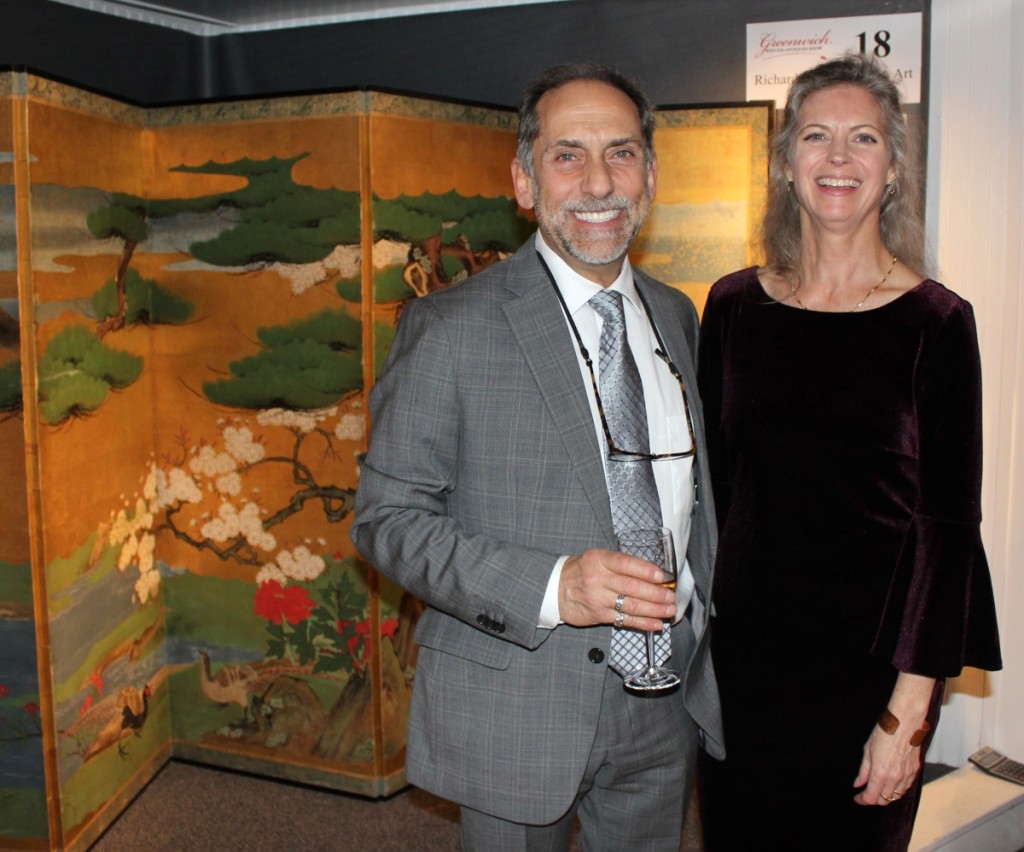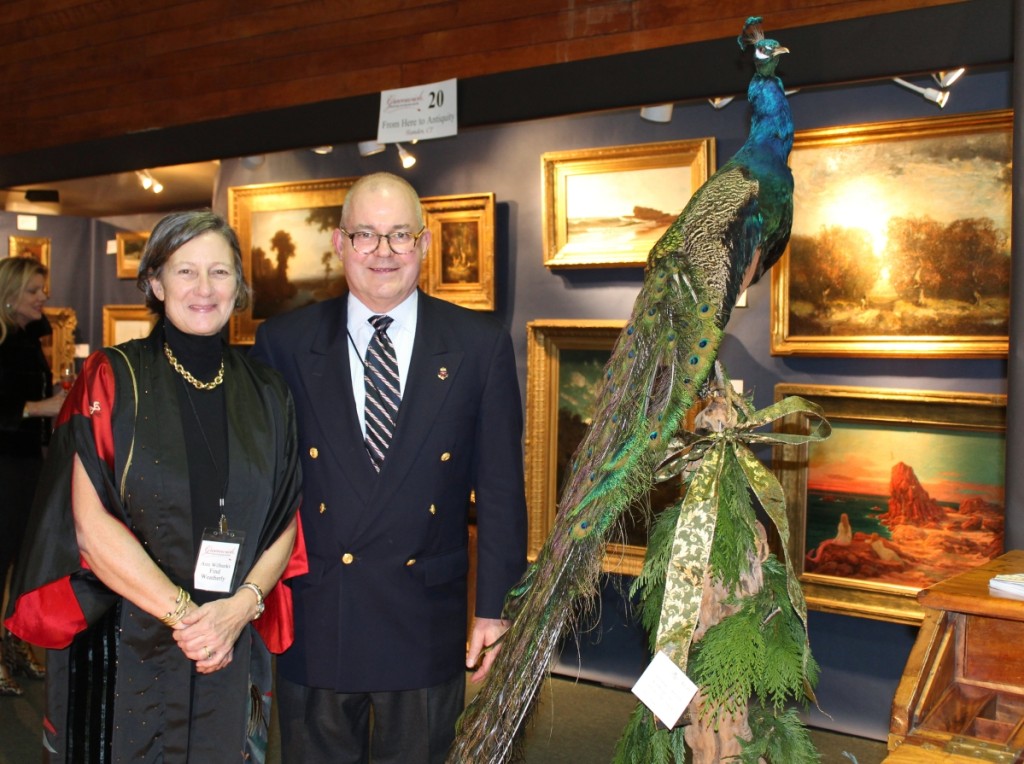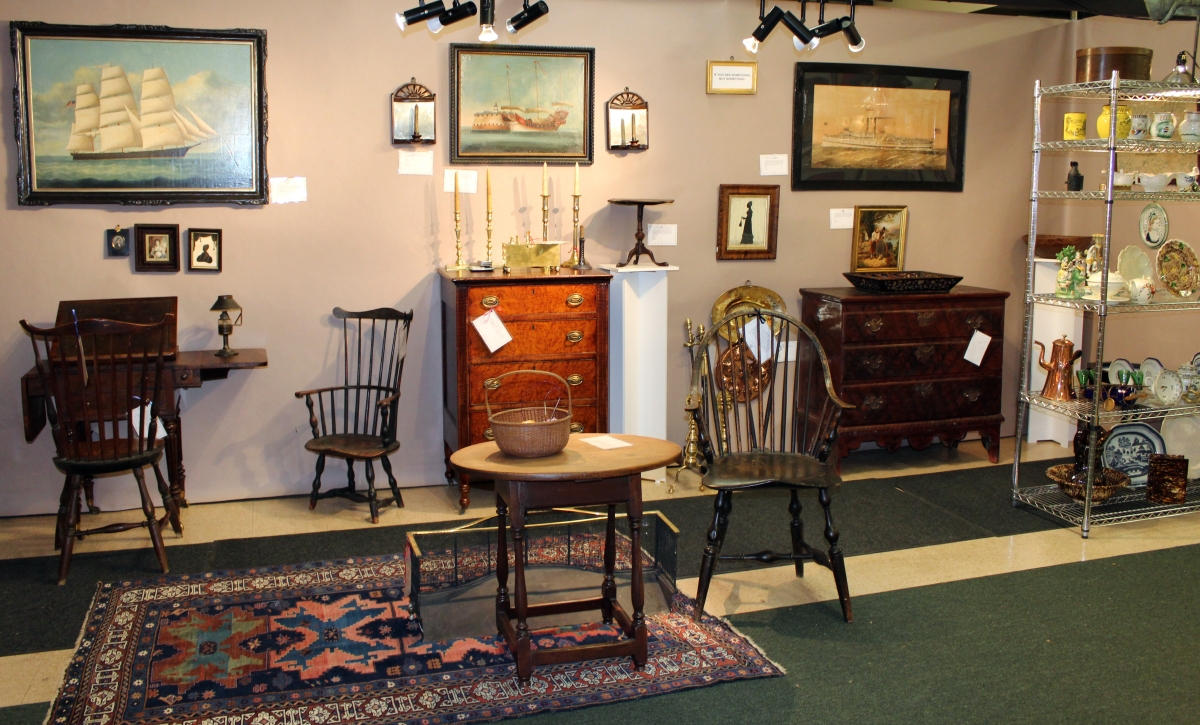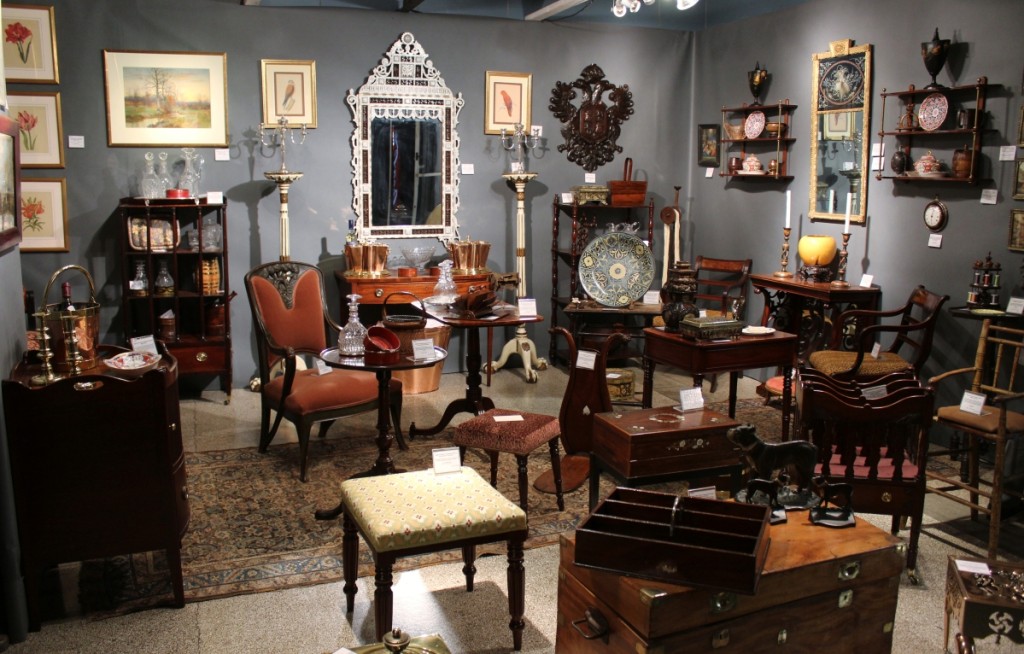Review and Photos by W.A. Demers
OLD GREENWICH, CONN. – The day before hundreds of festively attired guests streamed into the Eastern Greenwich Civic Center to preview the Greenwich Winter Antiques Show, the Dow hit a record 24,000 – a statistic that carries more weight here than does the day’s high temperature, inches of rain or snow, or any of the other metrics that usually accompany a show review.

Barn Star Productions show managers Frank Gaglio and Lynn Webb are all smiles as the Greenwich Antiques Show preview crowd arrives.
While some may view the stock market’s inexorable rise in 2017 as perhaps another example of “irrational exuberance,” the denizens of these suburbs – many in the financial services industry – may see it as utterly salubrious. And it would not be unrealistic to expect an antiques show promoter and his cadre of exhibitors to expect great things to happen in such an environment.
So it was on December 1 that dealers and supporters of the Greenwich Historical Society gathered at this Asian-themed event to kick off a weeklong series of events under the Antiquarius umbrella – there are holiday boutiques, house tours, lectures and more. The preview gala was festive, with packed aisles and entrance, as usual. The two weekend days that followed, however, were quieter, according to many dealers.
Benefiting the Greenwich Historical Society, the show is managed by Barn Star Productions of Rhinebeck, N.Y., and offers a wide variety of merchandise, including fine art, marine art, estate jewelry, American and Continental furniture, prints, handbags and more from the Eighteenth Century to the mid-Twentieth Century.
Barn Star’s Frank Gaglio acknowledged that following a record attendance for the preview – more than 300 – the gate for the remainder of the weekend was “soft,” perhaps due to the fact that the show is just one part – and the first – in a gauntlet of ancillary Antiquarius events. “I will say that it was the most beautiful show ever with a real interesting floor – dealers like Bob Withington with European and American furnishings and garden ornaments, and Heller Washam with Eighteenth and early Nineteenth Century American furniture, accessories, paintings and folk art. It was just a great mix of merchandise,” said Gaglio.
Said Ann Wilbanks of Stamford, Conn.-based Find Weatherly, “We had a decent show with all sales of smalls, including four miniature carved birds, a good decoy, a fine carved wood gilt eagle and a couple of vintage German Santas. Most sales were to customers from my Stamford retail location.” An American late Nineteenth-early Twentieth century oil on canvas portrait of a pirate in a period gilt frame shared a corner space in the booth with an American Depression-era child’s “make-do” toy carnival built onto a Victrola phonograph base.

Standing proudly next to their peacock are Ann Wilbanks and her husband, George, of Find Weatherly, Stamford, Conn. Ann was getting as many compliments about her bespoke jacket as for the peacock. The jacket is made from antique kimono silks by a woman from New Orleans who, according to Ann, has the magical name Starr Hagenbring.
A choice piece of maritime ephemera was a late Nineteenth-early Twentieth Century album with a treasure trove of yachting photos – including rare interior views – many of them America’s Cup yachts.
Jewelry, not surprisingly, fared better than other categories here. Still selling even days after the show closed, Dana Kraus of DK Farnum, New Canaan, Conn., characterized her experience as “a very good show; sold 20 pieces, several to longtime clients who come each year to the show for which we are grateful.” Those sales included work from JAR (Joel Rosenthal, the famed Place Vendome jeweler), Schlumberger, Cartier, Hermes and Van Cleef & Arpels.
“The most costly purchase was a pair of fabulous Schlumberger ‘ribbon’ earrings with diamond ‘caged’ drops,” added Kraus. “Caroline Kennedy wore a similar pair, which belonged to her mother, to her wedding. They were made in the 1960s, signed Schlumberger and in the original presentation case.”
Kraus was situated at the front of the main hall in the civic center and flanking each side of the entrance with a good chunk of real estate was David Smernoff, the Cheshire, Conn., dealer whose aptly named business From Here to Antiquity showcases art and antiques ranging from antiquity to Old Masters to Modern masters. Indeed, Smernoff owned the Twelfth Century carved stone guardian lion head and partial torso, Ankor period, Khmer, that was displayed at the show’s entrance – and getting a lot of photo “op” attention by attendees – as well as a 1972 Modernist take on a Renaissance concert by Argentinian artist Vito Campanella (1932-2014).
Smernoff and his partner Flavia are celebrating his firm’s 40 anniversary in 2018 and he prepared a special four-color catalog of select merchandise for the occasion. As you can imagine, Smernoff’s inventory is encyclopedic, but a few notable highlights at this outing were a small, exquisite depiction of a fountain in Naples by Raffaele Armando Mundo (Italian, 1857-1930), Arthur E. Schneider’s “House by a Lake,” circa 1910, and “Paris Tuileries Garden,” circa 1872, by Jean Francois Raffaelli (French, 1850-1924).
American fine art, especially American Impressionism and the Lyme Art Colony, is plentiful at The Cooley Gallery, Old Lyme, Conn. Co-owner Jeff Cooley pointed out three works by Laura Coombs Hills (1859-1952), all pastel on paper still lifes, “Yellow Roses #16,” 21 by 18 inches, “Blue & White,” 21 by 17¼ inches, and “Sweet Peas & Roses,” 14¼ by 12 inches. A sweeping landscape by contemporary Vermont artist Eric Aho, titled “Far Sky,” was almost vertiginous. Aho paints Vermont landscapes as well as those in the Southwest, Ireland, Scandinavia and Russia.
There was choice furniture offered by several dealers at the show, and one of them, Don Heller of Heller Washam Antiques, Portland, Maine, said that he was just the third owner of an incredible piece – a circa 1780-1800 apothecary chest, originally from Dorchester, Mass., but moved to Boston in the 1940s by horse and wagon in the midst of wartime gas rationing. Standing on tall square legs, the piece had two parts, the top consisting of banks of drawers with pained apothecary labels flanking a central cupboard, and the bottom section featuring two drawers flanking a pull-out mixing slide with cupboard below.
Additional furniture gems were shown by Old Lyme, Conn., dealers Hanes & Ruskin in the form of what they called a “Big Man” Windsor chair. The dealers theorized that sometime between 1790 and 1800 in New York City, a big man asked a chairmaker (possibly John Sprosen) to make him a comfortable chair. This 200-year-old survivor had an uncharacteristically wide saddle and a seat height of 19 inches to accommodate long legs. It had to be sturdy, hence the brace back. Also on offer by the dealers was a circa 1840 China trade oil on canvas of the Dutch Folly in the Pearl River, Canton, with a junk in the foreground, most likely a war junk commonly seen during the Opium Wars.
For additional information, www.barnstar.com or 845-876-0616.


































